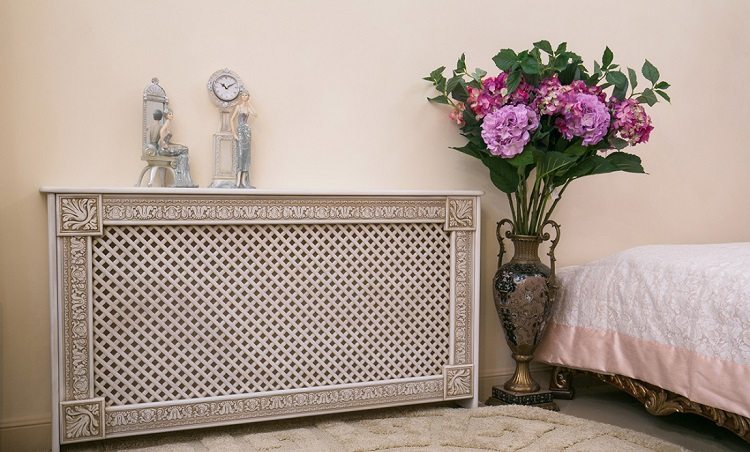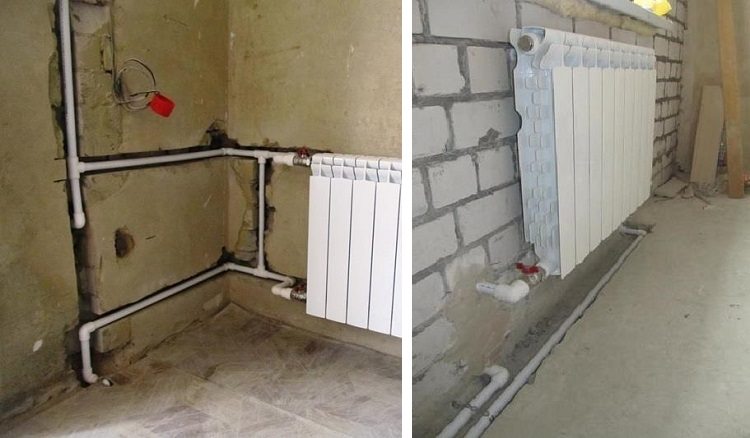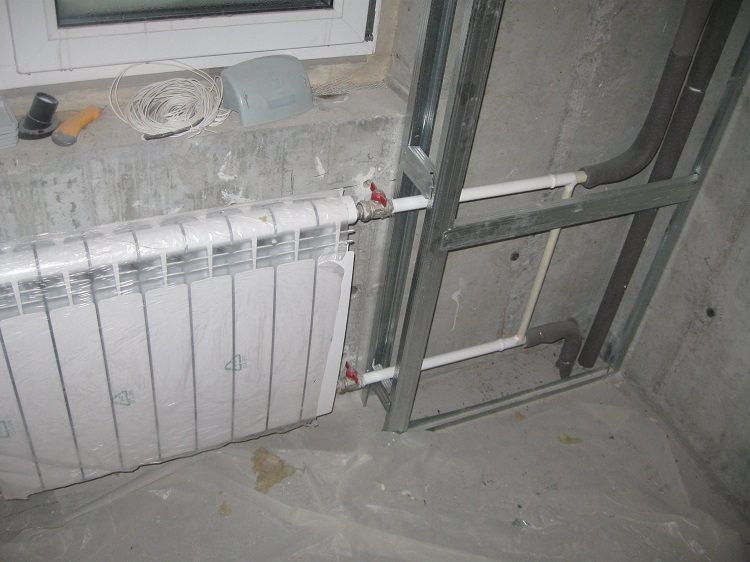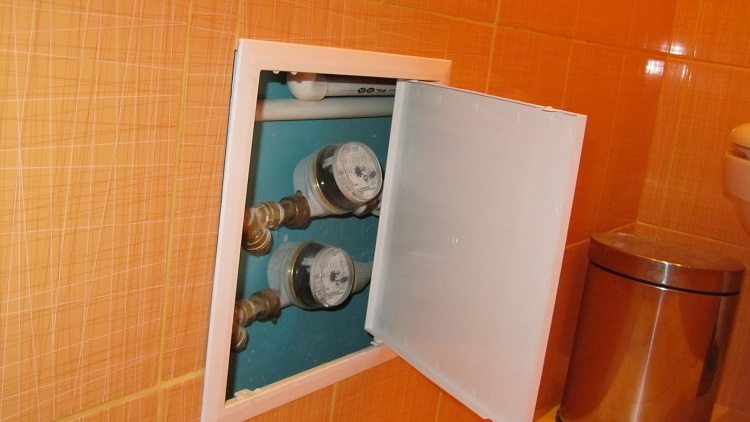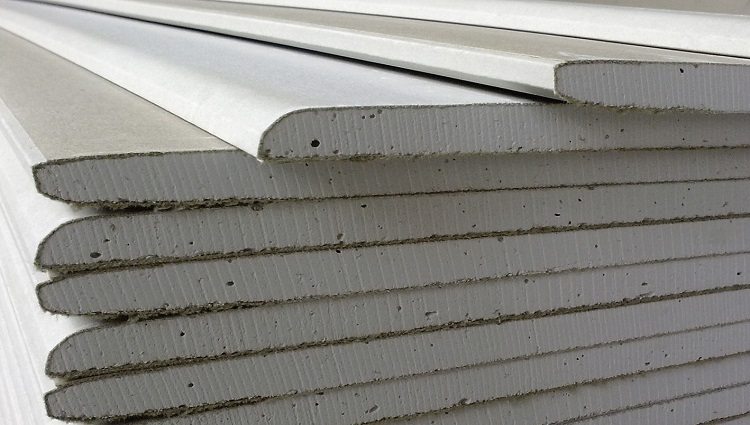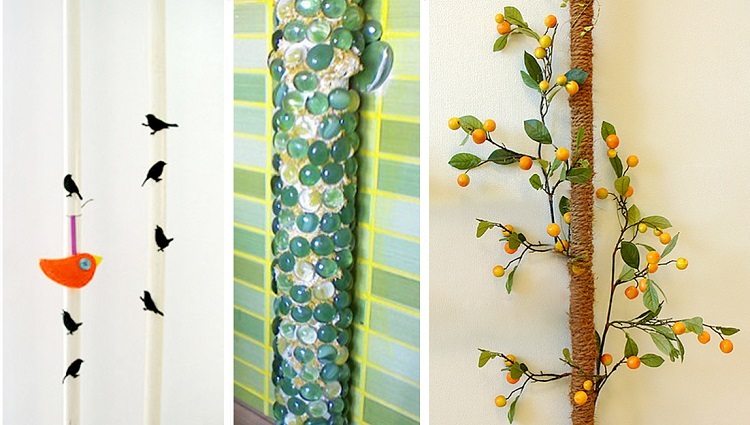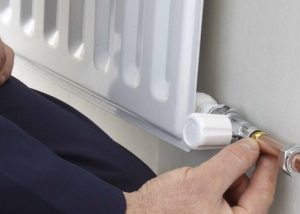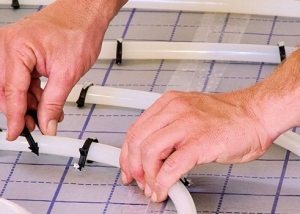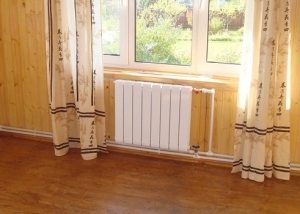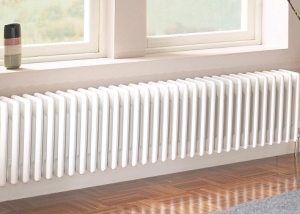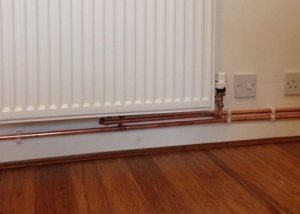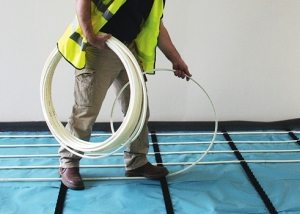Leaving communications open, you can ruin the look of any room. It is not always easy to hide heating pipes both in private houses and in apartments, without affecting their functionality. Masking of pipelines in the apartment is difficult because of their size. There are many options for hiding heating pipes, and all of them depend on the design features of the communications.
Content
Methods for hiding heating pipes
The simplest case is the conduct of new construction, when there is an opportunity in advance to think about how to hide the heating pipes. If necessary, close the pipeline in the kitchen, in a private house, apartment or room, the list of options is as follows:
- brick up horizontal or vertical struts in the wall;
- use the decoration of the heating pipe;
- distribute the system behind a suspended ceiling;
- install decorative screens on pipes laid open;
- integrate a floor heating system;
- close the pipes with drywall (by mounting a wall or box);
- hide pipes under the raised floor.
It should be borne in mind that in an apartment building it is impossible to transfer central heating pipes without coordination with the relevant organizations.
The best solution for how to hide a heating pipe in an apartment is to decorate it or disguise it. Choosing the right option depends on the need to hide the radiator. In this case, it is necessary to ensure the free conversion of warm air. To hide the heating pipes in the room, as in the kitchen, at a sufficient temperature, you can by making a box of drywall. The radiator can be closed with metal or plastic grilles, or perforated panels.
Helpful advice: The use of a foil insulation improves the heat transfer of the radiator and leads to a temperature increase of 2 degrees.
How to hide heating pipes in private homes
The choice of how to close heating pipes in private houses depends on the design features of the building. If there is a concrete floor, the pipes can be included in its heating system. Important is the implementation of screed and insulation of the base. Mandatory is the laying of a layer of polystyrene foam and the use of damper tape.
If there is no need for floor heating, then you can make strobes in the floor and lay pipes with thermal insulation in them. By conducting a heating main in this way, it is possible to create conditions for the maximum efficiency of the heating system. It is necessary to provide a margin of 10 mm for pipes for the shtrob, which will give room for a heat insulator and a bonding solution. Pipes are attached to the floor with brackets or special clips. Before closing the heating pipe on the floor, you must make sure that the butt joints are completely tight.
Private buildings are often made of wood, which makes it possible to easily hide heating pipes in private homes. Alternatively, you can extend the pipeline through the logs by drilling holes for the pipes. It is important that there is a margin of safety in order to ensure the reliability of the entire structure.
Concealing pipes using a duct made of different materials
In the event that heating has already been laid, you can hide the pipe both in the apartment and in the private house in the box. It can be plastic, wooden, drywall and is mounted on a frame. Before closing the heating pipe with a box in an apartment or house, you should correctly calculate its size. The parameters of the box depend on the number of pipes, their diameter and the distance between them. Provide a gap of a few centimeters between the walls of the box and the pipes, which is associated with volumetric and linear expansion of the pipes.
How to hide the heating pipe in the box in the room:
- Make a frame from wooden blocks or a metal profile and attach it to the wall with screws.
- Depending on the location of the pipes, mark on the floor, wall, ceiling.
- Mount the rack profile to the wall, fix the guides on the ceiling and floor, mount the corner profiles.
- Carry out the lining of the frame. First fix the side elements, then the central ones. Further, the decor is at your discretion: you can paint, wallpaper, apply backlighting, etc.
If the distance between the posts is more than 25 cm, then additional parallel jumpers are necessary. Horizontal jumpers are required if the rack height is more than 150 cm.
Important! In a private house, before you hide the heating pipes, you must make sure that the duct has a supporting surface, that is, it is forbidden to hang it.
Concealing pipes in walls or floors
It should be noted that to conceal the pipeline it is better to choose any other available method than to close the heating pipe in the wall or floor, having walled it up. Pipes must be freely accessible for repair in the event of a breakdown.
Is it possible to hide heating pipes in the wall, depends on their material. So, it is allowed to lay stainless and copper pipes, metal-plastic pipes on press joints, cross-linked polyethylene. Pipes made of polypropylene, metal-plastic with compression fittings cannot be laid in the wall. In order to hide the pipe in the room or kitchen, a wall with the required width and depth should be made in the wall. Next, place a thermally insulated pipe in it and perform finishing work.
You can wall up only a flat part of the pipe without joints, because according to the technical requirements, free access should be provided to:
- counters;
- taps for blocking the flow;
- flange, threaded connections;
- pumps
- expansion tanks and other equipment.
Before closing the heating pipes in the room in the wall or floor, it is necessary to put on special covers to reduce heat loss and test the system. It will also be necessary to draw up a scheme for laying heating pipes so that possible repairs in the future do not lead to the destruction of the integrity of the hidden mains.
Using drywall to mask pipes
The most common way to close the heating pipes with drywall. Both in the room and in the kitchen around a horizontal or vertical riser, you can build a frame of galvanized profiles or wooden beams and sheathe it with drywall. There are two options for using this material: creating a box or a false wall.
Whether to close the heating pipe with drywall can be decided based on the following wishes:
- Before hiding metal-plastic pipes in a box or behind a false wall, when connecting which collapsible fittings were used, they should be replaced by press fittings.
- If the piping is old, then it should be replaced before you hide the heating pipes in the kitchen or in the room.
- Pipes made of copper and steel should be closed with insulating material.
- Polypropylene pipes should not be closed at all.
- In places where couplings, tees, and corners are installed, special doors should be made, especially in the kitchen, in order to quickly access them in an accident.
The advantages of using drywall are the low cost of work, the availability of materials, the ability to quickly access pipes, as well as the easy dismantling of the drywall construction if necessary. A false wall is constructed according to the same principle as the box, but it takes away some area from the room. Next, you can lay a tile on it, wallpaper it, and paint it decoratively.
Helpful advice: It is recommended to use a screener when hiding pipes with drywall, which will avoid the appearance of bumps on its surface.
Using decoration
There are many options for decorating heating pipes. How to decorate the heating pipe can be decided based on the general interior.
Sometimes, for example, in the kitchen, it is acceptable to simply paint the pipe in the color of the walls. This will provide moisture resistance, endurance to temperature changes, safety for human health. Otherwise, you can paint the pipes. It is necessary to apply paint on a cold circuit, since on hot it will dry quickly and then crack.
A good option to close the pipes in the room, kitchen, bathroom is the use of screens. They are made from wood, MDF sheets, metal and have a wide range of colors and shapes. In addition, their installation is quick and easy, only fixing in some places is necessary - and the heating pipes in the room are decorated. The better the screen is selected, the better will be the heat transfer of the riser. Perforated screens should be selected to allow air circulation in the room. You can use stained-glass screens to decorate the heating pipe, as an option, with a backlight.
Separately, it is necessary to highlight such a case as heating pipes under the ceiling. You can decorate them with hiding cornices, twisting around with twine, using ropes, textiles, ribbons, buttons, etc.

